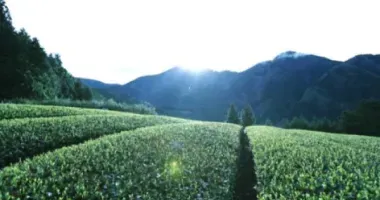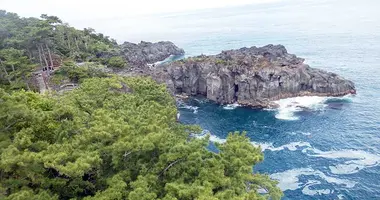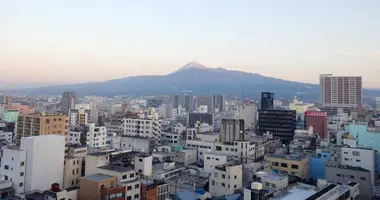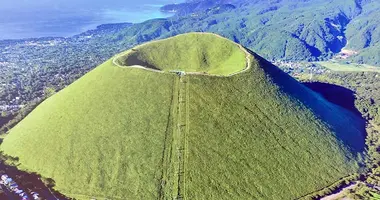Heda Guide Shizuoka
Heda is a small fishing village on the Izu Penininsula in Shizuoka Prefecture known for its views of Mount Fuji and its spider crab cuisine.
- Arriving in Heda
- Heda Harbor Road
- Mihama Peninsula
- Kenko no Mori Viewpoint
- The Russian Connection
- Spider Crab Restaurants
- Heda Ichi no Yu Onsen
- Accommodation
- How to get to Heda
- Japan City Guides
Heda, Numazu, Shizuoka Prefecture 戸田 沼津 静岡県
Johannes Schonherr

Mount Fuji seen behind Mihama Peninsula, Heda, Shizuoka Prefecture
Located on the western shore of the Izu Peninsula in Shizuoka Prefecture, the village of Heda is a remote spot. From the nearest train station, Shuzenji, the southern terminus of Izuhakone Railway's Sunzu Line, it takes about 50 minutes by bus on winding, mountain roads to reach the coastal village.
Although the fishing village of about 3,700 inhabitants has belonged to Numazu city since 2005, there is virtually no direct public transport connection between Numazu and Heda. While a direct ferry between Numazu and Heda ports called the White Marine II is still marked on most Numazu tourist maps, the ferry discontinued its services in 2014.
Yet, as remote as it may be, Heda is definitely worth the trip. It offers not only spectacular views of Mount Fuji but Heda is Japan's center for the fishing of spider crab, the largest crab on earth, at least in terms of leg span. Many restaurants along the harbor road offer delicious crab cuisine to their customers.

Fishermen repairing nets, Heda, Izu Peninsula, Shizuoka Prefecture
Arriving in Heda
Taking the bus from Shuzenji, you can occasionally spot Heda from far up in the mountains. Nestled in a valley, Heda stretches out to a small bay almost sealed off from the sea by the narrow, flat Mihama Peninsula. The peninsula provides an ideal harbor for Heda. Beyond the peninsula are the waters of Suruga Bay, Japan's deepest bay.
The bus terminates at a road crossing named Heda Junction close to the bay. The local tourist information office is right behind the bus terminal. It is hardly marked though and when you enter, you feel like interrupting the sole guy on the premises in his deep studies of the Kojiki or a similarly heavy tome.

Mount Fuji seen from Mihama Peninsula, Heda, Shizuoka Prefecture
Heda Harbor Road
Heda is a slow village. Stroll towards the Mihama Peninsula clearly visible on the other side of the bay.
Local fishermen repair their nets, they work on their boats. Anglers patiently dangle their fishing rods over the harbor water, hoping for a catch. The registration plates on the cars next to them indicate that they are not locals. They come from as far as Tokyo or Nagoya and might have a vacation house somewhere in the vicinity.
Walk on towards the Mihama Peninsula. Soon, the most famous view of Heda will come in sight: the view of Mount Fuji behind the opening of Heda Bay, framed by the Mihama Peninsula to the left and the hilly mainland to the right. On the tip of pine tree covered Mihama Peninsula you can spot a bright red shrine gate.
The viewing spot itself is not marked. You have to keep your eyes open - and of course, you need a bright clear day to see the iconic mountain.

Sand beach on Mihama Peninsula with view towards Heda
Mihama Peninsula
The Mihama Peninsula offers a wide sand beach towards Heda, popular with sunbathers and swimmers in the summer. The outer beach towards the Suruga Bay consists of large cobble stones.
From there, you have an unimpeded view towards Mount Fuji behind the Suruga Bay with the occasional sailing boat traveling by.
Behind the large red shine gate is a small Shinto shrine, serenely resting in the shade of large pine trees.

View from the Kenko no Mori Viewspot, Heda, Shizuoka Prefecture
Kenko no Mori Viewpoint
The Kenko no Mori is only a short walk uphill from the Mihama Peninsula. It offers wide views over the peninsula, out to Suruga Bay and of course towards Mount Fuji.

Memorial stones for the Russian sailors who died in the sinking of the Diana, Hosenji Temple, Heda
The Russian Connection
Strolling back on the harbor road, you will notice a large seaside stone marker. Additional memorial stones accompany it, telling a very particular story in both Japanese and Russian.
In November 1854, shortly after Commodore Perry's second visit to Japan and his signing of the Convention of Kanagawa resulting in the opening of two Japanese ports to American trade, the fleet of Russian Admiral Yevfimy Putyatin arrived at Shimoda Port on the southern end of the Izu Peninsula to negotiate a similar agreement between Japan and the Russian Empire.
On December 23rd 1854, a heavy earthquake shook the area, resulting in a 7 meter tall tsunami. Admiral Putyatin's entire fleet was destroyed by the tsunami with the exception of his flagship, the frigate Diana. Severely damaged, the Diana sailed towards Heda for repairs. Heda was known for its long tradition of shipbuilding. The Diana never made it to Heda. It sank in Suruga Bay.
The surviving Russian sailors were brought to Heda, however. Together with local carpenters they constructed a western style ship, a schooner eventually named Heda to thank the people of the village for their help and hospitality.
In April 1855, after successfully negotiating and signing the Treaty of Shimoda which opened three Japanese ports to Russian ships, Admiral Putyatin and his party returned safely to Saint Petersburg on board of the Heda.
At Hosenji Temple in central Heda, you find a memorial stone for the Russian sailors who had died in the sinking of the frigate Diana.

Back street in central Heda, Izu Peninsula, Shizuoka Prefecture

Spider crab restaurant, Heda, Izu Peninsula
Spider Crabs
Japan's main fishing grounds for the spider crab, taka-ashi-gani in Japanese, are in the deep waters of Suruga Bay. The main harbor for the catches is Heda - and Heda is the best place to eat them fresh from the sea.
A spider crab can achieve a leg span of 3 to 4 meters. The crabs served in Heda restaurants however span rarely more than one meter.
The season for the crab is autumn and winter - the same time when the air is usually clear enough to enjoy the Fuji views.
To enjoy the real experience of eating a spider crab, it's best to visit Heda with a few friends. Say, a group of about 4 people.
That way, you can order a whole freshly cooked crab taken straight out of the water basin where they are kept alive.
Together with your friends, you can then extract the delicious meat from its hard shell. A meal consisting of a whole spider crab costs about 15,000 yen in a Heda restaurant.
Heda Ichi no Yu Onsen
What can be better than a hot spring bath after a delicious meal? Heda offers that too. The main public onsen bath of the village is called the Heda Ichi no Yu and it is just a short walk inland from Heda Junction.
Opening times: daily from 10 am to 9 pm
Admission is 500 yen for adults, 250 yen for children.
Tel: 0558 94 5151
Address: Numazu City, Heda 1294-2
Website in Japanese: kururaheda.com/spa

Heda seen from the Shuzenji - Heda bus
Accommodation
Heda offers a wide variety of small inns, including many family-run inns with their own hot springs. Online, most of them are bookable via the travel section of e-commerce site Rakuten in Japanese for very reasonable prices.
There are three hotels / ryokan in Heda, all of them equipped with their own hot spring baths: the Nishiizu Kayoi Onsen, the Yamaichi Ryokan and the Gyoan Sasaya Hotel.
Access - Getting to Heda
From Tokyo
From Tokyo Station, take the Kodama Shinkansen of the Tokaido Shinkansen Line running between Tokyo and Osaka, to Mishima Station, change there to Izuhakone Railway's Sunzu Line to Shuzenji. From Shuzenji Station take the bus to Heda. The bus trip is 1000 yen one way.
From Numazu
Though Heda belongs officially to Numazu, you have to travel outside of Numazu to reach Heda. Take a JR Tokaido Line train from Numazu Station to Mishima, only one stop away. From there, follow the directions given above to travelers heading for Heda from Tokyo.
The tourist information counters in Numazu have a very informative English-language booklet on Numazu available which also covers Heda.
The Numazu Tourist Information Office offers an informative website in English. You can read the pages on Heda here on a PDF.

Heda manhole cover, Izu Peninsula, Shizuoka Prefecture

















